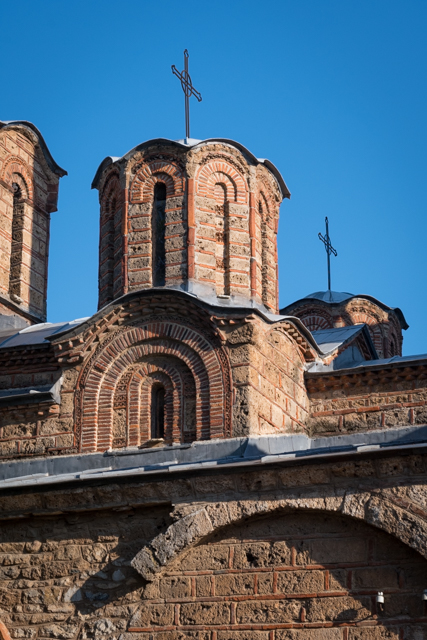



















The day’s sightseeing got off to a bad start; we’d given ourselves time to visit the old railway station – so good the gift shops have fridge magnets of it – and the Ethnographic museum before breakfast. Unfortunately we couldn’t get out of the hotel as the front door was locked and there’s no alternative exit – safe? The breakfast waiter finally arrived and we were released but had to abandon the railway station plan. The museum wasn’t yet open (it’s very secretive about its opening hours). We’d seen mention of 7:00 somewhere; there’s nothing at the museum or on its website; the garage next door thought 8:00 – maybe. It was just after 7:30 so the four of us adjourned to a café next door, very nice coffee. 8:00 came and went with no signs of activity so we returned to the hotel for breakfast and packing.
At 9:30, we left for Prizren, our home for the next two nights.
Our guide added in an unscheduled stop at Gjakova on the way. This town, like many others was badly bombed during the war. Since then however they have been luckier than most – they have a Harvard educated female mayor who has done a huge amount to regenerate the town and restore the tolerance it was historically known for. She regularly wins ‘Mayor of the Year’ awards – based on measures such as transparency and good governance. The town was famous for its Grand Bazaar, some of this has been rebuilt with a lot of wooden single storey shops. The main street is lined with cafes and bars; it’s very pleasant. The town is known for its craftsmen, one street is dedicated to making wooden cradles, another one saddles. The highlight is the Hadumi mosque, built in 1594. We’re allowed in for five minutes only as it’s Friday. Inside is quite plain but with some attractive paintings on the inside of the domed roof. When are five minutes are up, we move on to a café across the street, more very good coffee for me, and some laid back music to go with it – it would be nice to stay here much longer.
It’s another 45 minutes to Prizren. On the way we cross a new bridge adjacent to very old stone construction. The original Terzijski bridge was built at the end of the 15th Century. Unusually the top of the bridge follows the rise and fall of each of the 11 arches.
Prizren is said to be Kosovo’s most attractive town. The compact centre spreads along the banks of the Prizren Bistrica river and has some Ottoman and Byzantine architecture. The town is noticeably more eastern than others we have visited. There are 35 mosques, although not many more women wear headdresses and shawls and there is a stronger Turkish influence.
After checking into out hotel, we walked to the central square to Besimi restaurant, known for traditional dishes. We had a mix of salads, grilled peppers, an immense piece of fresh flat bread and some haloumi like djathë I Sharrit cheese – all very tasty, Florence followed this with a Tullumba – a desert soaked in honey. After lunch, we wandered aimlessly around the square, through some back streets and across the river to see what caught our eye then back to the hotel for a rest – it feels like one of the hottest days of the trip so far.
We left for a guided walk around the town at 6:00. We saw the thank you messages on the town hall to a variety of countries who supported the independence of Kosovo. A few blocks back, we saw the outside of the beautiful 14th Century church of the Virgin of Ljeviš that hasn’t been fully renovated since the war, it’s Serbian orthodox and protected rather incongruously by razor wire. Our guide gave us a brief overview of the significance of Prizren to Albanian history – more tomorrow – beginning with the Congress of Berlin in 1878.
Dinner was a bit disappointing after our lovely lunch – the only options for us were pasta and pizza. The group spilt after dinner, half went to a music festival in the fort above the town, the techno and Balkan didn’t appeal to everybody so the rest of us had a few more drinks before bedtime, sitting on a terrace watching Prizren go by.

Nice Tallumba. I can taste it from here.
It was very nice, but a couple of mouthfuls are enough.
I thought 35 mosques sounded like a lot – so I looked it up. This is an extract from Wikipedia “During the 1999 Kosovo War, 218 out of 540 mosques in Kosovo (nearly 40%) were destroyed by state forces (Federal Republic of Yugoslavia)”